
Louis Comfort Tiffany was an American artist and designer who worked in the decorative arts and is best known for his work in stained glass. He is associated with the art nouveau and aesthetic art movements. He was affiliated with a prestigious collaborative of designers known as the Associated Artists, which included Lockwood de Forest, Candace Wheeler, and Samuel Colman. Tiffany designed stained glass windows and lamps, glass mosaics, blown glass, ceramics, jewellery, enamels, and metalwork. He was the first design director at his family company, Tiffany & Co., founded by his father Charles Lewis Tiffany.
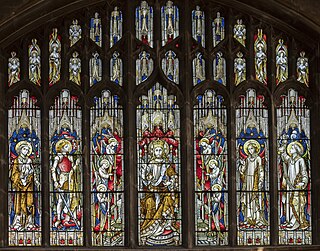
Hardman & Co., otherwise John Hardman Trading Co., Ltd., founded 1838, began manufacturing stained glass in 1844 and became one of the world's leading manufacturers of stained glass and ecclesiastical fittings. After the doors closed at Lightwoods Park Justin Hardman, a descendant of John Hardman kept the heart of the studio alive and with the help of chief designer, Artist Edgar JB Phillips they continue to design and manufacture exquisite traditional Hardman stained glass around the world.

A revival of the art and craft of stained-glass window manufacture took place in early 19th-century Britain, beginning with an armorial window created by Thomas Willement in 1811–12. The revival led to stained-glass windows becoming such a common and popular form of coloured pictorial representation that many thousands of people, most of whom would never commission or purchase a painting, contributed to the commission and purchase of stained-glass windows for their parish church.

William Warrington, (1796–1869), was an English maker of stained glass windows. His firm, operating from 1832 to 1875, was one of the earliest of the English Medieval revival and served clients such as Norwich and Peterborough Cathedrals. Warrington was a historian of medieval glass and published an illustrated book The History of Stained Glass.
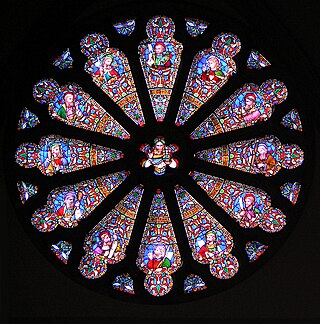
William Wailes (1808–1881) was the proprietor of one of England's largest and most prolific stained glass workshops.
The firm of James Powell and Sons, also known as Whitefriars Glass, were London-based English glassmakers, leadlighters and stained-glass window manufacturers. As Whitefriars Glass, the company existed from the 17th century, but became well known as a result of the 19th-century Gothic Revival and the demand for stained glass windows.

Clayton and Bell was one of the most prolific and proficient British workshops of stained-glass windows during the latter half of the 19th century and early 20th century. The partners were John Richard Clayton (1827–1913) and Alfred Bell (1832–1895). The company was founded in 1855 and continued until 1993. Their windows are found throughout the United Kingdom, in the United States, Canada, Australia and New Zealand.

Heaton, Butler and Bayne was a British firm that produced stained-glass windows from 1862 to 1953.
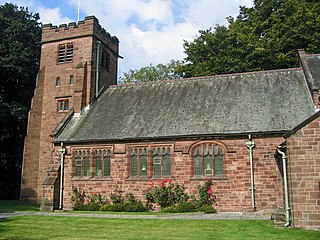
St John the Evangelist's Church is in the village of Sandiway, Cheshire, England. It is an active Anglican parish church of Sandiway and Cuddington in the diocese of Chester, the archdeaconry of Chester and the deanery of Middlewich. The church is recorded in the National Heritage List for England as a designated Grade II listed building.
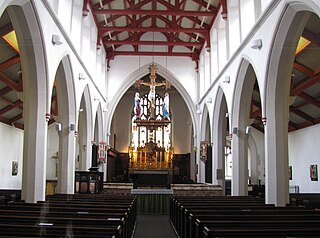
St Matthew's Church, more usually known as St Matthew's Carver Street, is situated on Carver Street in the centre of Sheffield, South Yorkshire, England. It is a Grade II listed building located at grid reference SK351871. The church is part of the Anglo-Catholic movement.
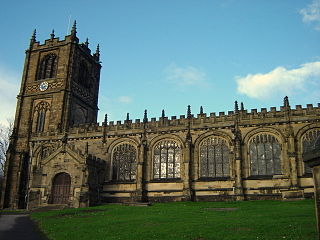
St Mary's Church is an Anglican parish church in Mold, Flintshire, Wales, and a Grade I listed building. It belongs to the Deanery of Mold, the Archdeaconry of Wrexham and the Diocese of St Asaph of the Church in Wales. It has historical associations with the Stanley family, Earls of Derby and displays heraldic symbols of this, including an Eagle and Child assumed by the family in the 15th century, and the Three Legs of Man, derived from a time when the Stanleys were Lords of Mann. Under Father Rex Matthias, the previous incumbent, the church took on an Anglo-Catholic style of liturgy.

Nathaniel Hubert John WestlakeFSA (1833–1921) was a 19th-century British artist specialising in stained glass.
Philip Westlake was a 19th-century British painter, the brother of Nathaniel Westlake, one of the partners in Lavers, Barraud and Westlake, Ecclesiastical Designers.

Holy Trinity Platt Church, is in Platt Fields Park in Rusholme, Manchester, England. It is an active Anglican parish church in the deanery of Hulme, the archdeaconry of Manchester, and the diocese of Manchester. The church is recorded in the National Heritage List for England as a designated Grade II* listed building. It is the second "pot church" designed by Edmund Sharpe, so-called because the main building material used in the construction of the church is terracotta.

All Saints Church is in Blackburn Road in the village of Higher Walton, Lancashire, England. It is an active Anglican parish church in the deanery of Leyland, the archdeaconry of Blackburn, and the diocese of Blackburn. The church is recorded in the National Heritage List for England as a designated Grade II listed building.
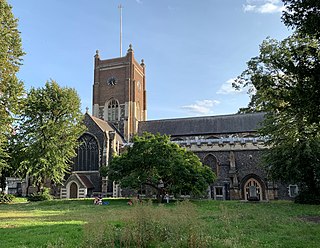
All Saints Church is the historic parish church of Kingston upon Thames in southwest London, and is set between the ancient Market Place and the main shopping centre. It forms part of the Diocese of Southwark and together with the church of St John, and St John the Divine, it forms a team of Anglican churches serving residents, businesses, schools and Kingston University. The church is the only Grade I listed building in Kingston.

John William Brown (1842–1928) was an English painter and stained glass designer. He was employed by Morris & Co. and later by James Powell and Sons, before he became a freelance designer, when he continued to undertake commissions for Powell's. His major works include the Lady Chapel windows and the east window of Liverpool Cathedral.

Lewis Foreman Day was a British decorative artist and industrial designer and an important figure in the Arts and Crafts movement.

St Andrew's Church, Surbiton, is one of two Church of England parish churches in Surbiton, London – the other is St Mark's. It is dedicated to Saint Andrew, and is situated at the junction of St Andrew's Road and Maple Road.
Alfred Alexander Webster (1883-1915) was a Scottish stained glass artist in the early nineteenth century. His talent established him as the successor to the Glasgow stained glass designer Stephen Adam who in turn considered Daniel Cottier to be his master. Webster was considered one of the most accomplished artists working in stained-glass during this period. Websters Theatre, Glasgow on 416 Great Western Road, Glasgow is named after Webster as the building contains two major stained glass windows designed by him.


















